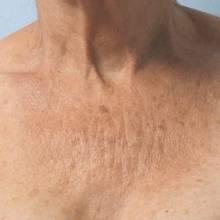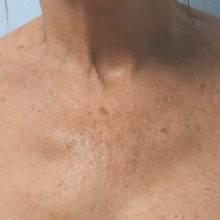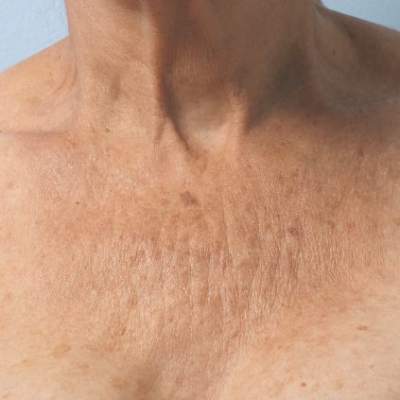User login
NEW ORLEANS – Micro-focused ultrasound with visualization can effectively treat lines and wrinkles of the décolletage by penetrating deeply enough into the skin to promote tissue restructuring, according to Dr. Sabrina Guillen Fabi.
When treating women with sagging skin, lines, and wrinkles who want to invest in rejuvenating their facial skin, don’t overlook the skin of the décolleté, Dr. Fabi stressed at the annual meeting of the American Academy of Cosmetic Surgery.
Various devices are currently available to combat components of skin aging, including rhytids, but they are only able to treat the superficial layers of skin with wavelengths possessing limited energy penetration capabilities, said Dr. Fabi of Goldman Butterwick Fitzpatrick Groff & Fabi Cosmetic Laser Dermatology in San Diego. Ultrasound, however, can be focused to specific depths, penetrating deep enough to cause thermal coagulation and restructuring of tissue. “Micro-focused ultrasound combines the ability to actually see what you’re treating – similar to how we’ve used ultrasound to visualize babies for over 50 years – with focused ultrasound waves at predetermined depths,” she explained.
To evaluate the effectiveness of using micro-focused ultrasound with visualization (MFU-V) to demonstrate aesthetic improvement in lines and wrinkles of the décolleté, Dr. Fabi and colleagues conducted a prospective multicenter trial of 125 patients with an average age of 57 years.
Based on masked assessments, 70.5% of patients showed some level of improvement at 90 days, and at 180 days it was relatively maintained at 67%. Physician Global Aesthetic Improvement Scale (PGAIS) scores showed that 75.0% of subjects improved at 90 days and 66% at 180 days.
At the 90-day visit, 84% of subjects noted an improvement in their skin and 65.5% were satisfied with their results. Day 180 results showed a similar trend, with 83% of subjects noting improvement and 62.7% satisfied. “Although they reported improvement in their wrinkles, they weren’t satisfied,” noted Dr. Fabi. “Patients with that much wrinkle severity have a lot of other problems on their chest such as redness and brown spots, which need to be addressed separately. So 65% of subjects were satisfied even though 84% reported improvement,” she added.
Each patient received a single MFU-V treatment on the chest using three transducers: 4-4.5 mm (1.2J), 7-3.0 mm (0.45 J), and 10-1.5 mm (0.20 J). All participants were rated as a grade of 4 or higher on the Fabi/Bolton Chest Wrinkle 5-point scale. Grade 4 is characterized by deep rhytids, well-defined lines, and dyschromia; grade 5 is defined by very deep rhytids with redundant folds, also accompanied by dyschromia. “This treatment takes less than 20 minutes with no downtime,” said Dr. Fabi.
Using a validated scale (0-10), subjects reported their average level of discomfort during the treatment, and pain was managed with oral pretreatment medications such as ibuprofen. Photographs were taken prior to treatment, immediately after treatment, and at each follow-up visit (day 90 and day 180).
Efficacy was determined by using both the PGAIS and the Subject Global Aesthetic Improvement Scale, Patient Satisfaction Questionnaire responses, masked assessments of photographs compared with baseline, and the Fabi/Bolton chest wrinkle scale, all tabulated at 90 and 180 days post treatment.
No serious adverse events were reported. The most frequent adverse event was soreness or tenderness, which was experienced by 38% of subjects; 22% showed some level of redness after treatment, but that usually dissipated within about 24 hours, Dr. Fabi noted. The mean pain score at each depth was 6.2 at 4.5 mm, 5.9 at 3.0 mm, and 4.8 at 1.5 mm.
All adverse events were mild except two (1.9%) that were moderate, one of which was not device related. All events were resolved.
Agreement was noted across all measures of efficacy at days 90 and 180, suggesting that post-treatment improvements in lines and wrinkles of the décolleté were clinically significant, she said.
Significant reduction of wrinkles and lines, as well as tightening and toning of the décolleté, was observed at 3 and 6 months after a single treatment using MFU-V; Dr. Fabi and her colleagues are seeking FDA clearance of MFU-V treatment based on these results. “This modality helps patients at least have their décolletage match their face after some sort of facial rejuvenation procedure, whether it be nonsurgical or surgical,” said Dr. Fabi. “Severely wrinkled patients may need additional treatments, but more importantly, I think if you address the dyschromia in addition to the wrinkles, you may have greater patient satisfaction,” she suggested.
Dr. Fabi reported serving as a consultant and advisory board member for device manufacturer Ulthera.
NEW ORLEANS – Micro-focused ultrasound with visualization can effectively treat lines and wrinkles of the décolletage by penetrating deeply enough into the skin to promote tissue restructuring, according to Dr. Sabrina Guillen Fabi.
When treating women with sagging skin, lines, and wrinkles who want to invest in rejuvenating their facial skin, don’t overlook the skin of the décolleté, Dr. Fabi stressed at the annual meeting of the American Academy of Cosmetic Surgery.
Various devices are currently available to combat components of skin aging, including rhytids, but they are only able to treat the superficial layers of skin with wavelengths possessing limited energy penetration capabilities, said Dr. Fabi of Goldman Butterwick Fitzpatrick Groff & Fabi Cosmetic Laser Dermatology in San Diego. Ultrasound, however, can be focused to specific depths, penetrating deep enough to cause thermal coagulation and restructuring of tissue. “Micro-focused ultrasound combines the ability to actually see what you’re treating – similar to how we’ve used ultrasound to visualize babies for over 50 years – with focused ultrasound waves at predetermined depths,” she explained.
To evaluate the effectiveness of using micro-focused ultrasound with visualization (MFU-V) to demonstrate aesthetic improvement in lines and wrinkles of the décolleté, Dr. Fabi and colleagues conducted a prospective multicenter trial of 125 patients with an average age of 57 years.
Based on masked assessments, 70.5% of patients showed some level of improvement at 90 days, and at 180 days it was relatively maintained at 67%. Physician Global Aesthetic Improvement Scale (PGAIS) scores showed that 75.0% of subjects improved at 90 days and 66% at 180 days.
At the 90-day visit, 84% of subjects noted an improvement in their skin and 65.5% were satisfied with their results. Day 180 results showed a similar trend, with 83% of subjects noting improvement and 62.7% satisfied. “Although they reported improvement in their wrinkles, they weren’t satisfied,” noted Dr. Fabi. “Patients with that much wrinkle severity have a lot of other problems on their chest such as redness and brown spots, which need to be addressed separately. So 65% of subjects were satisfied even though 84% reported improvement,” she added.
Each patient received a single MFU-V treatment on the chest using three transducers: 4-4.5 mm (1.2J), 7-3.0 mm (0.45 J), and 10-1.5 mm (0.20 J). All participants were rated as a grade of 4 or higher on the Fabi/Bolton Chest Wrinkle 5-point scale. Grade 4 is characterized by deep rhytids, well-defined lines, and dyschromia; grade 5 is defined by very deep rhytids with redundant folds, also accompanied by dyschromia. “This treatment takes less than 20 minutes with no downtime,” said Dr. Fabi.
Using a validated scale (0-10), subjects reported their average level of discomfort during the treatment, and pain was managed with oral pretreatment medications such as ibuprofen. Photographs were taken prior to treatment, immediately after treatment, and at each follow-up visit (day 90 and day 180).
Efficacy was determined by using both the PGAIS and the Subject Global Aesthetic Improvement Scale, Patient Satisfaction Questionnaire responses, masked assessments of photographs compared with baseline, and the Fabi/Bolton chest wrinkle scale, all tabulated at 90 and 180 days post treatment.
No serious adverse events were reported. The most frequent adverse event was soreness or tenderness, which was experienced by 38% of subjects; 22% showed some level of redness after treatment, but that usually dissipated within about 24 hours, Dr. Fabi noted. The mean pain score at each depth was 6.2 at 4.5 mm, 5.9 at 3.0 mm, and 4.8 at 1.5 mm.
All adverse events were mild except two (1.9%) that were moderate, one of which was not device related. All events were resolved.
Agreement was noted across all measures of efficacy at days 90 and 180, suggesting that post-treatment improvements in lines and wrinkles of the décolleté were clinically significant, she said.
Significant reduction of wrinkles and lines, as well as tightening and toning of the décolleté, was observed at 3 and 6 months after a single treatment using MFU-V; Dr. Fabi and her colleagues are seeking FDA clearance of MFU-V treatment based on these results. “This modality helps patients at least have their décolletage match their face after some sort of facial rejuvenation procedure, whether it be nonsurgical or surgical,” said Dr. Fabi. “Severely wrinkled patients may need additional treatments, but more importantly, I think if you address the dyschromia in addition to the wrinkles, you may have greater patient satisfaction,” she suggested.
Dr. Fabi reported serving as a consultant and advisory board member for device manufacturer Ulthera.
NEW ORLEANS – Micro-focused ultrasound with visualization can effectively treat lines and wrinkles of the décolletage by penetrating deeply enough into the skin to promote tissue restructuring, according to Dr. Sabrina Guillen Fabi.
When treating women with sagging skin, lines, and wrinkles who want to invest in rejuvenating their facial skin, don’t overlook the skin of the décolleté, Dr. Fabi stressed at the annual meeting of the American Academy of Cosmetic Surgery.
Various devices are currently available to combat components of skin aging, including rhytids, but they are only able to treat the superficial layers of skin with wavelengths possessing limited energy penetration capabilities, said Dr. Fabi of Goldman Butterwick Fitzpatrick Groff & Fabi Cosmetic Laser Dermatology in San Diego. Ultrasound, however, can be focused to specific depths, penetrating deep enough to cause thermal coagulation and restructuring of tissue. “Micro-focused ultrasound combines the ability to actually see what you’re treating – similar to how we’ve used ultrasound to visualize babies for over 50 years – with focused ultrasound waves at predetermined depths,” she explained.
To evaluate the effectiveness of using micro-focused ultrasound with visualization (MFU-V) to demonstrate aesthetic improvement in lines and wrinkles of the décolleté, Dr. Fabi and colleagues conducted a prospective multicenter trial of 125 patients with an average age of 57 years.
Based on masked assessments, 70.5% of patients showed some level of improvement at 90 days, and at 180 days it was relatively maintained at 67%. Physician Global Aesthetic Improvement Scale (PGAIS) scores showed that 75.0% of subjects improved at 90 days and 66% at 180 days.
At the 90-day visit, 84% of subjects noted an improvement in their skin and 65.5% were satisfied with their results. Day 180 results showed a similar trend, with 83% of subjects noting improvement and 62.7% satisfied. “Although they reported improvement in their wrinkles, they weren’t satisfied,” noted Dr. Fabi. “Patients with that much wrinkle severity have a lot of other problems on their chest such as redness and brown spots, which need to be addressed separately. So 65% of subjects were satisfied even though 84% reported improvement,” she added.
Each patient received a single MFU-V treatment on the chest using three transducers: 4-4.5 mm (1.2J), 7-3.0 mm (0.45 J), and 10-1.5 mm (0.20 J). All participants were rated as a grade of 4 or higher on the Fabi/Bolton Chest Wrinkle 5-point scale. Grade 4 is characterized by deep rhytids, well-defined lines, and dyschromia; grade 5 is defined by very deep rhytids with redundant folds, also accompanied by dyschromia. “This treatment takes less than 20 minutes with no downtime,” said Dr. Fabi.
Using a validated scale (0-10), subjects reported their average level of discomfort during the treatment, and pain was managed with oral pretreatment medications such as ibuprofen. Photographs were taken prior to treatment, immediately after treatment, and at each follow-up visit (day 90 and day 180).
Efficacy was determined by using both the PGAIS and the Subject Global Aesthetic Improvement Scale, Patient Satisfaction Questionnaire responses, masked assessments of photographs compared with baseline, and the Fabi/Bolton chest wrinkle scale, all tabulated at 90 and 180 days post treatment.
No serious adverse events were reported. The most frequent adverse event was soreness or tenderness, which was experienced by 38% of subjects; 22% showed some level of redness after treatment, but that usually dissipated within about 24 hours, Dr. Fabi noted. The mean pain score at each depth was 6.2 at 4.5 mm, 5.9 at 3.0 mm, and 4.8 at 1.5 mm.
All adverse events were mild except two (1.9%) that were moderate, one of which was not device related. All events were resolved.
Agreement was noted across all measures of efficacy at days 90 and 180, suggesting that post-treatment improvements in lines and wrinkles of the décolleté were clinically significant, she said.
Significant reduction of wrinkles and lines, as well as tightening and toning of the décolleté, was observed at 3 and 6 months after a single treatment using MFU-V; Dr. Fabi and her colleagues are seeking FDA clearance of MFU-V treatment based on these results. “This modality helps patients at least have their décolletage match their face after some sort of facial rejuvenation procedure, whether it be nonsurgical or surgical,” said Dr. Fabi. “Severely wrinkled patients may need additional treatments, but more importantly, I think if you address the dyschromia in addition to the wrinkles, you may have greater patient satisfaction,” she suggested.
Dr. Fabi reported serving as a consultant and advisory board member for device manufacturer Ulthera.
AT THE AACS ANNUAL MEETING



